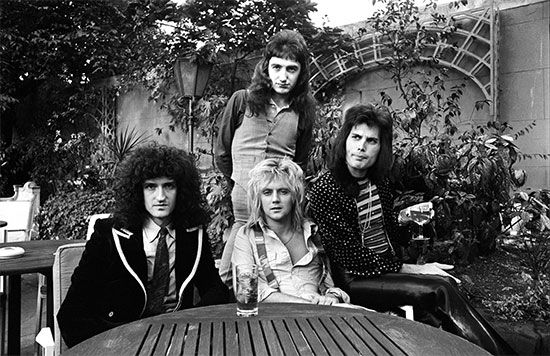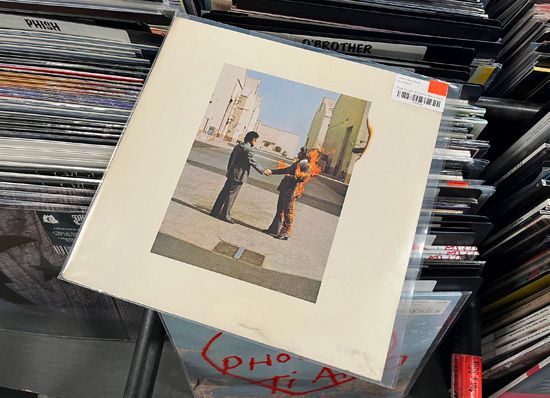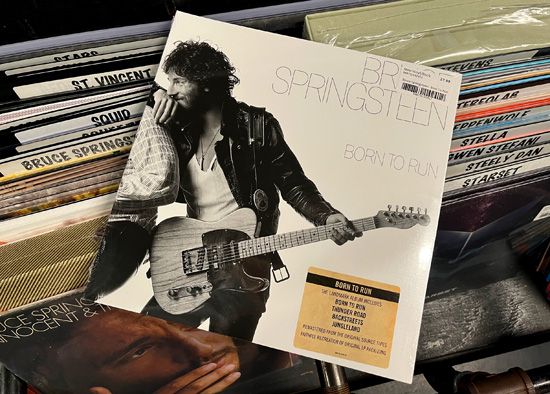List of Albums that Turn 50 in 2025
- Related Topics:
- popular music
The year 1975 delivered a wave of groundbreaking music—a sonic explosion that rewrote the rules of rock, pop, and everything in between. From electrifying guitar solos to soulful anthems and genre-bending experiments, artists were pushing boundaries and setting new standards. It was a year when legends were born, legacies were solidified, and classics were carved into history. This list celebrates the musical magic of that era, inviting readers to bend an ear to a selection of some of the most iconic albums of 1975.
Queen: A Night at the Opera
- A Night at the Opera spent four weeks at number one and 44 weeks in total on the album charts in the United Kingdom following its release.
- The album became Queen’s first to gain platinum certification in the United States.
- At the time of its release, A Night at the Opera was the most expensive album ever produced, at about £40,000 (nearly $420,000 [U.S.] in 2025).
Queen’s A Night at the Opera, which ranks among the greatest albums of all time, spawned “Bohemian Rhapsody,” an iconic work that spent nine weeks in the top spot on the British singles chart. The album is remarkable for its innovative production, fusion of grandiose ambition with razor-sharp musicianship, and melding of hard rock, opera, pop, and even vaudeville into a dazzling, theatrical experience. A Night at the Opera turned Queen into global superstars and proved that risk-taking in music could pay off in spectacular fashion. Its massive success influenced countless artists to embrace bold experimentation, and decades later the album still stands as a master class in creativity. The album also was groundbreaking for its massive production costs, being one of the most expensive albums ever made, and for its diverse songwriting from each member of the band.
Led Zeppelin: Physical Graffiti
- Physical Graffiti was the first album to sell one million copies in the United States via advance orders.
- The album reached number one on the Billboard charts within the first month of its release and stayed there for six consecutive weeks.
- Physical Graffiti contains a massive amount of music—15 songs that soak up 82 minutes and four sides of vinyl.
With Physical Graffiti, the first album released under British rock band Led Zeppelin’s label Swan Song Records, the group hit their zenith. Physical Graffiti was forged across years of recording sessions, which instilled in it a remarkable tapestry of sound, a blend of resurrected classics and new creations. The album captures the band’s most expansive and most fleeting studio moments as they pushed the limits of their craft. It charges through a fierce landscape of hard rock, evident in “The Rover,” and ventures into the vast realms of progressive rock and, in “Kashmir,” psychedelia. It also experiments fearlessly with other styles, which can be heard in the luring acoustics of “Bron-Yr-Aur.” Wrapped in a striking, intricately designed cover—so complex it challenged and ultimately delayed production—Physical Graffiti cemented Led Zeppelin’s place in rock and roll.
Pink Floyd: Wish You Were Here
- The cover of Wish You Were Here features stuntman Ronnie Rondell engulfed in flames. Rondell was set on fire multiple times before the final shot, the image on the cover, was captured.
- Wish You Were Here hit the number one spot on album charts in both the United States and the United Kingdom.
- Pink Floyd’s ninth studio album followed The Dark Side of the Moon (1973), their best-selling album.
Wish You Were Here captured Pink Floyd at the height of their creative powers, delivering an emotional, atmospheric masterpiece that resonated far beyond the world of progressive rock. Built on themes of absence, loss, and alienation—and a heartfelt tribute to former bandmate Syd Barrett—the album struck a universal chord with listeners who found beauty in its haunting soundscapes and introspective lyrics. Anchored by the epic “Shine On You Crazy Diamond” and the timeless title track, “Wish You Were Here,” the album deepened Pink Floyd’s reputation as pioneers of concept albums and sonic storytelling. The album’s influence can be felt across genres even today, inspiring generations of musicians to explore vulnerability and imagination in their art.
Bob Dylan: Blood on the Tracks
- Bob Dylan recorded Blood on the Tracks using open E tuning on his acoustic guitar, giving the tracks their distinctive sound.
- The only single from Blood on the Tracks, “Tangled Up in Blue,” leveled out at 31 on the Billboard Hot 100 chart; the album itself, however, spent two weeks at the top of the album chart.
- Blood on the Tracks was one of Dylan’s best-selling albums, reaching double-platinum status in the United States.
When Bob Dylan released Blood on the Tracks in 1975, it was more than just a return to form—it was a raw, emotional unraveling that redefined the power of personal songwriting. Blending heartache, regret, and flashes of bittersweet hope, Dylan transformed his own pain into a timeless portrait of love and loss. The album’s stripped-back sound and vivid storytelling reminded the world why he was one of music’s most essential voices, and it opened the door for future artists to embrace vulnerability in their work. Blood on the Tracks resonated with listeners and bled into the fabric of American songwriting, cementing its place as one of the most influential and emotionally charged albums ever made.
David Bowie: Young Americans
- Young Americans peaked at number nine on the Billboard charts in the United States and reached number two on the U.K. albums chart.
- “Fame” was Bowie’s first chart-topping single in the United States.
- Young Americans had multiple working titles, among them Shilling the Rubes, in reference to using dishonesty to convince people to give up money. About avoiding the working title, Bowie remarked, “I was advised that my stunning wit would not go down well.”
With Young Americans, David Bowie redefined the possibilities of pop music. The album marked a bold departure from Bowie’s glam rock roots, diving headfirst into the world of soul, funk, and rhythm and blues. Bowie called it “plastic soul,” but there was nothing fake about the emotional power and slick grooves he captured. Featuring hits such as “Fame” and the soaring title track, “Young Americans,” the album broadened Bowie’s audience, cracked the American mainstream, and showed that constant reinvention could be an artist’s greatest strength. Its influence rippled across decades, inspiring musicians to blur genres, embrace transformation, and never be afraid to chase a new sound.
Fleetwood Mac: Fleetwood Mac
- Fleetwood Mac reached number one on the Billboard 200 chart more than a year after its release.
- The album is also known as The White Album, owing to its predominantly white cover design.
- Three top 20 singles came out of Fleetwood Mac: “Rhiannon,” “Over My Head,” and “Say You Love Me”; the single “Landslide” later also became popular.
The release of Fleetwood Mac’s self-titled album in 1975 marked the beginning of a new era for the band. With the arrival of guitarist and vocalist Lindsey Buckingham and singer-songwriter Stevie Nicks, the group’s chemistry caught fire, and a new sound, a blend of California dreaminess and raw emotional depth, emerged. Fleetwood Mac delivered shimmering pop hooks, aching ballads, and a sound that felt both effortless and electric. Tracks such as “Rhiannon” and “Landslide,” which were infused with mystical storytelling, climbed the charts, while “Monday Morning” and “Blue Letter” (a cover of the Curtis Brothers’ song) showed off Buckingham’s energetic guitar work and musical craftsmanship. The album, in reinventing Fleetwood Mac, transformed the band from a solid British blues act into one of the most iconic forces in rock history. The ripple effects of that transformation are still felt today, with the band’s influence heard in everything from indie pop to modern folk.
Joni Mitchell: The Hissing of Summer Lawns
- Rolling Stone magazine described The Hissing of Summer Lawns as the worst album title of the year in 1975.
- The Hissing of Summer Lawns influenced various artists, including Prince, who ranked it among his favorite albums.
- “In France They Kiss on Main Street,” which peaked at 66 on the Billboard charts, was the only single released from The Hissing of Summer Lawns.
In 1975 Canadian singer-songwriter Joni Mitchell once again proved that she was an artist unafraid to challenge expectations. The Hissing of Summer Lawns was a clear departure from the bare simplicity of her earlier work. Mitchell instead embraced lush, layered arrangements that blended jazz, pop, and world music influences into something entirely her own. The album’s sharp, poetic observations of suburban life, gender roles, and modern disillusionment were ahead of their time, offering a cool, complex take on American society, which critics and artists would come to revere. Though it sparked debate upon its release, owing in part to its satirical portrayal of housewives, The Hissing of Summer Lawns has since been hailed as a bold, visionary piece of storytelling that expanded the boundaries of the singer-songwriter realm.
Parliament: Mothership Connection
- With Mothership Connection, Clinton introduced the concept of the Mothership as a symbol of freedom and intergalactic cool.
- The track “Give Up the Funk (Tear the Roof Off the Sucker)” became one of Parliament’s biggest hits.
- Mothership Connection is a commonly sampled album, with its grooves and mythology inspiring artists from Public Enemy to Dr. Dre to Snoop Dogg.
When Parliament’s Mothership Connection landed, it blasted funk into a new universe. George Clinton and Parliament fused funk, soul, and science fiction into a wild, unstoppable force. With its rubbery basslines, cosmic themes, and larger-than-life characters, Mothership Connection made funk theatrical, political, and irresistibly danceable. Anthems such as “P-Funk (Wants to Get Funked Up)” and “Give Up the Funk (Tear the Roof Off the Sucker)” became instant classics, while the album’s Afrofuturist vision laid the groundwork for generations of artists, from hip-hop pioneers to today’s rhythm-and-blues innovators. Mothership Connection was more than an album—it was a movement, a mythology, and a way of life.
Neil Young and Crazy Horse: Zuma
- The album was named after Zuma Beach, which is located near Malibu, California, where Neil Young was living at the time.
- Zuma reached 25 on the Billboard album chart and 22 years after its release attained gold status for selling 500,000 units in the United States.
- The now-iconic track “Cortez the Killer” was cut short due to a power outage during recording; the last verse was lost, but Young decided to leave it that way.
Zuma marked a powerful resurgence for Canadian guitarist and singer-songwriter Neil Young, capturing the spirit and restless energy that would define much of his career. Reuniting with Crazy Horse after the death of guitarist Danny Whitten, Young created an album that was both loose and electrifying—a mix of ragged rock songs and wounded ballads that struck deep emotional chords. The remarkable and epic song “Cortez the Killer” showcased his gift for songwriting. Meanwhile, tracks such as “Don’t Cry No Tears” and “Danger Bird” brought sharp, bittersweet urgency. Zuma was neither polished nor tidy—and that was its magic. It reaffirmed Young’s place as one of rock’s most fearless and emotionally honest voices, a kind of imperfection as a form of authenticity.
Patti Smith: Horses
- Horses made it into the top 50 on the Billboard 200 chart in the United States and remained on the chart for 17 weeks.
- The first track on Horses, “Gloria,” a cover of the song originally written by Van Morrison, is known for its powerful opening line, “Jesus died for somebody’s sins, but not mine.”
- The photo on Horses, featuring Smith in a white shirt and black jacket slung over her shoulder, is considered one of the most influential album covers in rock history.
American singer-songwriter Patti Smith sparked a cultural revolution with her album Horses. Its raw fusion of poetry, punk attitude, and primal rock energy shattered expectations of a woman’s sound in music. Smith’s fearless voice—both literally and lyrically—challenged the norms of gender, art, and rebellion, opening a new frontier for punk rock before the genre even had a name. The album’s jagged brilliance, evident in its wild, unfiltered storytelling and in singular moments such as the haunting opening lines of “Gloria,” inspired later artists to embrace truth and vulnerability. Horses was far from polished—rather, it was alive and defiantly free, leaving a permanent mark on rock, punk, and the spirit of outsider art forever.
Bruce Springsteen: Born to Run
- Born to Run climbed to the third spot on the Billboard 200 chart and ultimately sold more than six million copies.
- In 2003 Born to Run was added to the Library of Congress National Recording Registry for its cultural importance.
- After two commercially unsuccessful albums, Born to Run was Bruce Springsteen’s last chance with Columbia Records; it success has been attributed to a combination of Springsteen’s musical brilliance and an intense marketing campaign.
Born to Run is a full-throttle declaration of youth, ambition, and American grit. With its soaring anthems, cinematic storytelling, and the sheer power of the E Street Band behind him, Bruce Springsteen captured the restless dreams of a generation hungry for something bigger. The album’s explosive title track, along with epic sagas, such as “Thunder Road” and “Jungleland,” turned Springsteen from a near failure into a rock icon almost overnight. Born to Run was desperate, defiant, and driven, setting a new standard for authenticity and craftsmanship in rock music. Decades later, it still stands as a timeless blueprint for anyone who has ever wanted to escape, believe in something better, or simply chase the open road.
Willie Nelson: Red Headed Stranger
- “Blue Eyes Crying in the Rain” spent two weeks in the top slot on the Billboard country singles chart.
- Red Headed Stranger spawned a movie of the same name, released in 1986 and starring Willie Nelson and Morgan Fairchild.
- The album was added to the Library of Congress National Recording Registry in 2009.
When Willie Nelson released Red Headed Stranger, it held out against every expectation. Stripped-down and deeply personal, the album broke with the cultivated Nashville sound of the time, offering instead a sparse, storytelling-driven concept album about love, betrayal, and redemption in the Old West. With little more than a guitar, piano, and Nelson’s unmistakable voice, Red Headed Stranger delivered emotional weight. Recording executives were skeptical, but listeners were captivated, and the album became a runaway success, led by the hit “Blue Eyes Crying in the Rain.” Red Headed Stranger helped launch the outlaw country movement, giving artists creative freedom. Its influence continues to echo through generations of country, folk, and Americana artists.




























